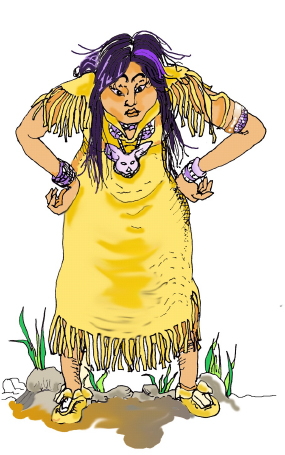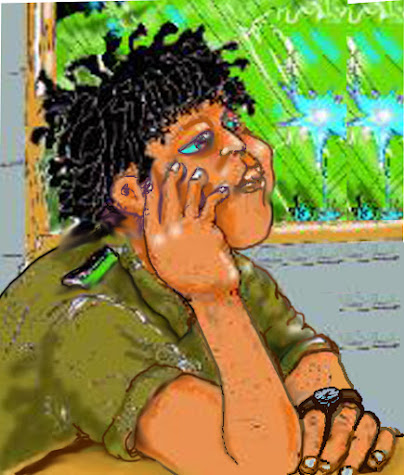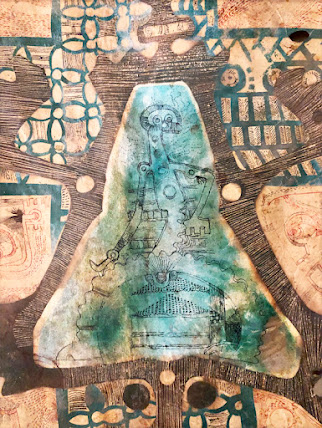Ticky-Ticky’s Adventures
A time to move on.
| Above: Anansi the Spider-Man with his Ghanaian children and their names associated with their abilities, None of them came to the Americas. |
Q: What is Anansi’s legacy in Jamaica?
A: There are numerous stories about Kweku Anansi the Spider-Man. They originated in Ghana among the Asanti. He was once a man who disrespected his father, N’yame the Great Sky God. His mother was Assase Ya, the Earth Goddess. For his slight against his father, N’yame turned his son into a small Spider-Man. In the Akan language, ananse means “spider”. Now a small creature suspended in a web between his mom, the Earth, and his dad, the Sky, this event made Anansi have to use his brain to survive larger animals and humans out to get him for his pranks. This is why children and the less fortunate have identified with him.
Arrival in Jamaica
He came to the Americas during the African Slave Trade and was known by many names. So Anansi spent centuries in the Jamaican psyche as Brer’ Annancy. Although he had a wife named Aso in Ghana, called Cookie in Jamaican lore, they had many children. But, only one child appears with Anansi in the island with him in Jamaican folklore. His son, Intikuma, is called Bra’ Takooma in local stories.
 |
| Intikuma Anansi or Ticky-Ticky, Anansi's youngest Jamaican son, with ancient Amerindian spider images around him. |
As a writer and storyteller, I decided to make this son have his own adventures. So, this is my version of the young Spider-Boy’s adventures. It introduces the reader to the Caribbean’s other ancient folkloric stories. This is Part 1 of a trilogy, set in the Taíno’s Bagua of the Caribbean Islands. In Parts 2 & 3 he travels by a time and reality transporting Bat-Canoe, with Opiyel, the Search-Dog of the Afterlife, loaned to him by Guyaba Maketaurie, God of Those Absent on Coabey, the Taíno Island of the Dead.
The Book
 |
| Above: Part one of the only novel on one of Anansi's sons, Toicky-Ticky. |
A Reader’s Comment
Spiderman’s Son
by Hugh Stringer
(For more on Anansi, go to anansistories.com)
"Ticky-Ticky’s Quest tells the story of a boy’s search for his father. The father, Anansi, was West African [the son of N’yame the Great Sky God of the Asanti]. The son, [Anansi] disrespected [N'yame] and was turned into a Spider-Man. Ticky-Ticky’s mother was a full-blooded woman, but she became progressively more spiderlike after the birth of each of her children. This is the first of a trilogy by Michael Auld.
It begins a year after Anansi leaves home and Ticky-Ticky embarks on a search to find him. His search takes him from Jamaica to Haiti to Florida. On his way, he learns Caribbean geography, history, linguistics, and folklore, and by dealing with the adversities of his quest he becomes a man. As a young man, Ticky-Ticky decides who he can and cannot trust and learns to distinguish right from wrong. His education is more consequential because he sees the world, for the first time from his own perspective: As a one-quarter spider, he must deal with the questions of identity that most full-blooded people never need to ask themselves. Before he sets out on his journey, he feels he must hide the fact that he is a “quarter spider.” He’s embarrassed by four legs. This is a story of how during his journey “living in a world of full-blooded humans,” he learns to forget he is a one-quarter spider.
His quest takes him to meet the characters that figure in Caribbean folklore. He sees and hears them in his mind’s eye and ear. Their images and voices pop into his head. In one episode, Ticky-Ticky hears the voice of the goddess of wind [Guabancex] and learns how hurricanes clean house: The Herald god [GuatuaBA!] announces the coming storm, and the Wind and Rain [Coatrisque the Deluge] gods clean up the “planetary trash” humans have left behind.
In another episode, on an island inhabited only by women [Matinino], Ticky-Ticky, “for the first time in his life, was accepted without judgment or questions.” He becomes so enamored of one of the women [Anacaona, future queen of Ayti's Haragua province] that for a time he forgets he is on a journey to find his father. Ticky-Ticky’s Quest is a compelling story from many perspectives: It is the story of what it means to be a boy, a man, and a human being capable of accepting people “without judgment or questions.
The Plot
Ticky-Ticky is a twelve-year-old with a secret: The youngest son of the infamous trickster Anansi the Spider-man. Hiding in the human world, Ticky-Ticky fears his father’s enemies will recognize and punish him for being the butt of Anansi’s embarrassing pranks. Now, the joke’s on Ticky-Ticky. A school incident forces him to follow his missing father’s footsteps on a dangerous quest across time and reality. Riding a magical ghost-bat canoe with a dog of the dead as his guide, Ticky-Ticky encounters Anansi’s folkloric foes out for revenge. After a lifetime of avoiding his father’s legacy, can Ticky-Ticky find his father before he loses his life or even worse: becomes just like him?
THE YOUNG QUARTER SPIDER-BOY’S DILEMMA
Ticky-Ticky sits in his Coromanti High School daydreaming about his life in his classroom. The teacher confronts him, ruler in hand, ready to smack the desk… or him!
“Mr. Ansnsi! Wake up!” She says in a stern voice. Mrs. Jellywoman is not having her students wander off into La-La Land in her class. Ticky-Ticky’s daydreaming was becoming a habit. So, having warned him before, she sends him to the headmaster for discipline with a cane beating on the bent-over buttock.
The British headmaster disciplines Ticky-Ticky and says.
“Don’t come back to school without your father!”
Holey crap! Ticky-Tivky’s dad, as Anansi had been off on an adventure for a year now!
Seeking Help
 |
|
Ticky-Ticky seeks advice from his best friend, Iggy the shapeshifter iguana.
“Man, you must try anything to find your dad!”
Iggy advises.
 |
| Osebo coming after Ticky-Ticky |
To make things worse, on his way to get help, Ticky-Ticky runs into Osebo the Terrible Leopard who is doing the same thing. Searching for Anansi for payback! He escapes Osebo’s claws!
 |
| Cuffy the Obeah-man, just caught puffer fish. |
Ticky-Ticky sought out Cuffy the Obeah-man who used the puffer fish’s toxic flesh to turn victims into zombies. He could also give a cohoba potion to visit the spirit world.
 |
| Guayaba Maketaurie, God of the Afterlife. The sweet guava fruit behind him is his symbol and namesake. |
The young Spider-Boy is sent to Coabey to visit Guayaba, Lord of the Afterlife via a Cuffy the Obeah-man's induced cohoba trance, and as the son of a god, is Guyaba's relative.
 |
| Opias, or the Spirits of the Absent hang on the cave's ceiling like bats that represent them. |
Visiting the Afterlife, he didn’t see his dad among the opias, the spirits.
 |
| Ticky-Ticky comes from under seagrape leave with Opiyel the Afterlife's Search Dog. An albino bat materializes out of Coabey, the Caribbean Island of the Afterlife. |
Guayaba loans Ticky-Ticky his search dog, Opiyel, and a Bat-Canoe that can travel across time and realities. But Haitian canoe-jackets attempt to hijack the canoe to Florida.
 |
| The hurricane is called Guabanxex, not any other imported names. Here she is as the Angry Woman Goddess, Rider of the Winds with her two accomplices, the roaring Herald and the devastating Deluge. |
Guabancex and her twin accomplices, GratauBa! the Herald thunder and lightning, and his brother, Coatrisque the Deluge, blow the Bat-Canoe off course.
They crash land on the twin Island of Woman, called Matinino or No Fathers where he meets and falls for Anacaona the Golden Flower.
Anansi is not there! But, could he have gone to America to find his rich Spider-Relatives there?
This storybook can be inexpensively bought at Amazon and Barnes & Noble at Amazon.com and
Barnes&Noble on how to purchase the digital or printed version.
A SNEEK PEEK AT THE NEXT NOVEL
 |
| Cover of Part 2 of the trilogy. |
 |
| Here the Bat-Canoe escapes Florida's alligator attack! |
 |
| Ticky-Ticky's visit to an American relative, the Cherokee's Grandmother Spider. |
 |
| Oh boy! Ticky-Ticky finds out about his cross-dressing spider-woman"Aunt Nancy" of the Sea Island people of South Carolina. Here she's caught by a tar-man trap. |
 |
| Brer' Rabbit's daughter. Bunny, is skeptical about Ticky-Ticky's authenticity as a folkloric descendant. |
 |
| Michabo the Great Hare's daughter Oginiminogawon questions Ticky-Ticky on his travels. But, there's lots more to come! |










